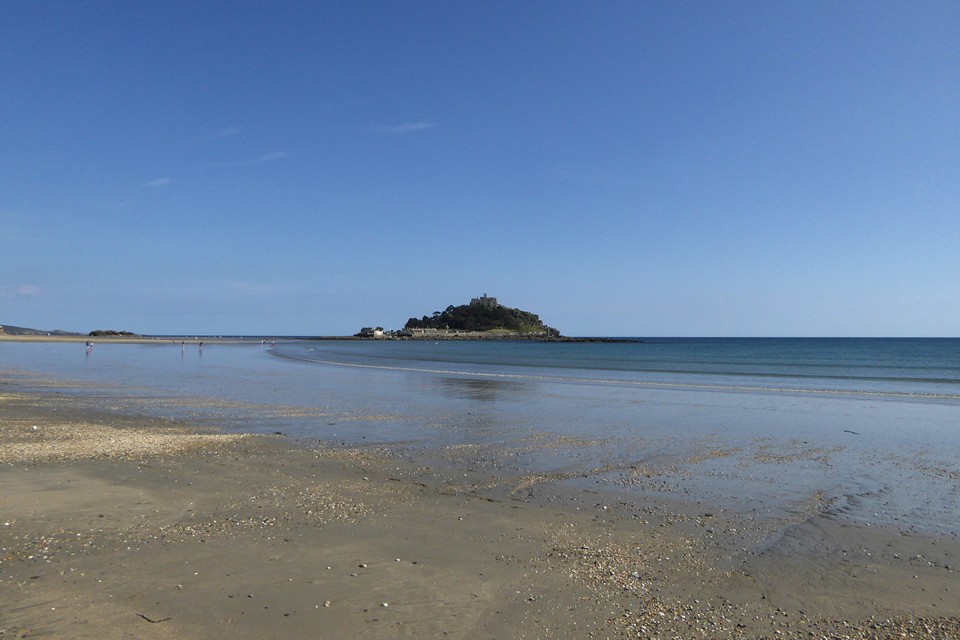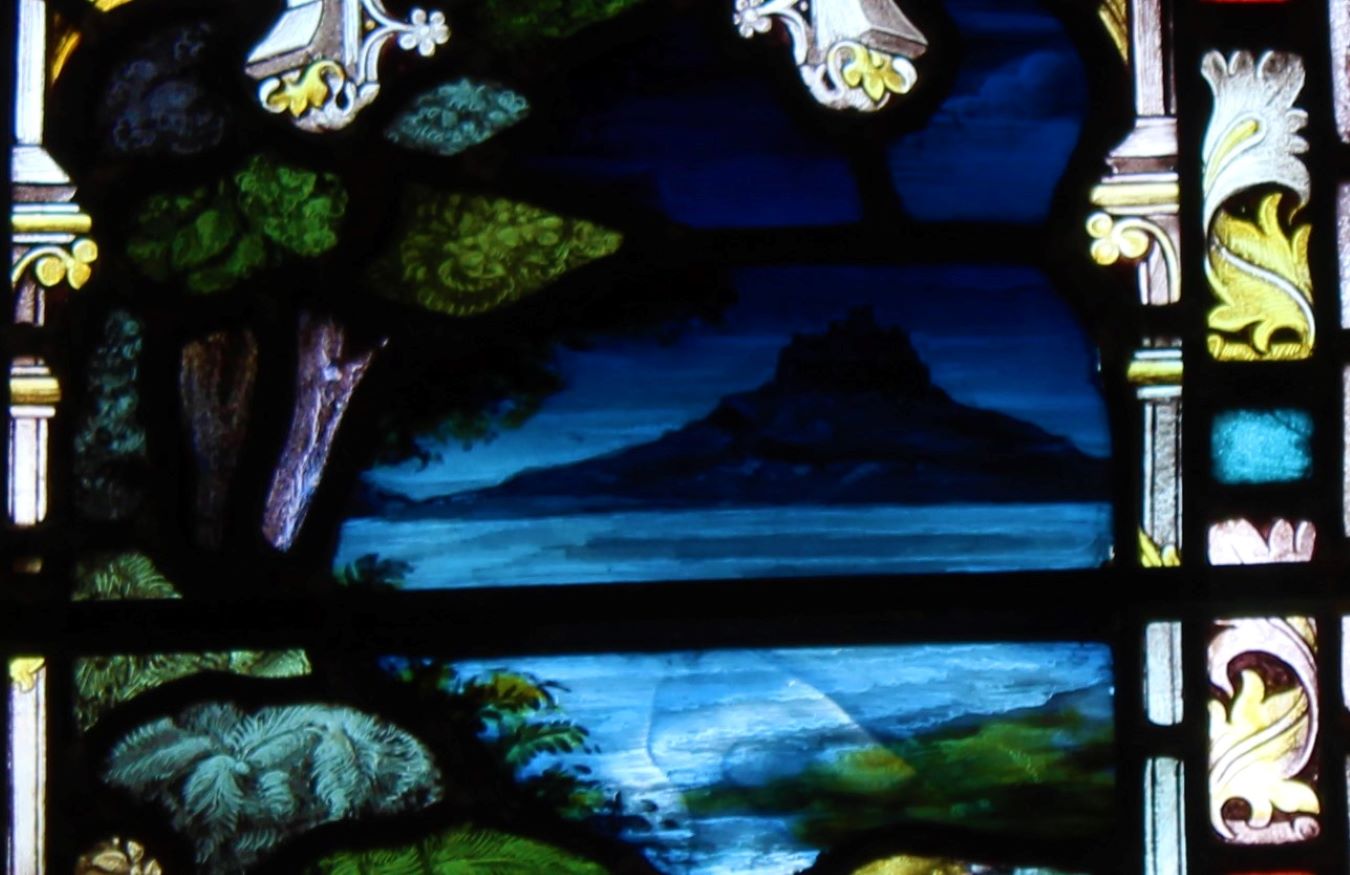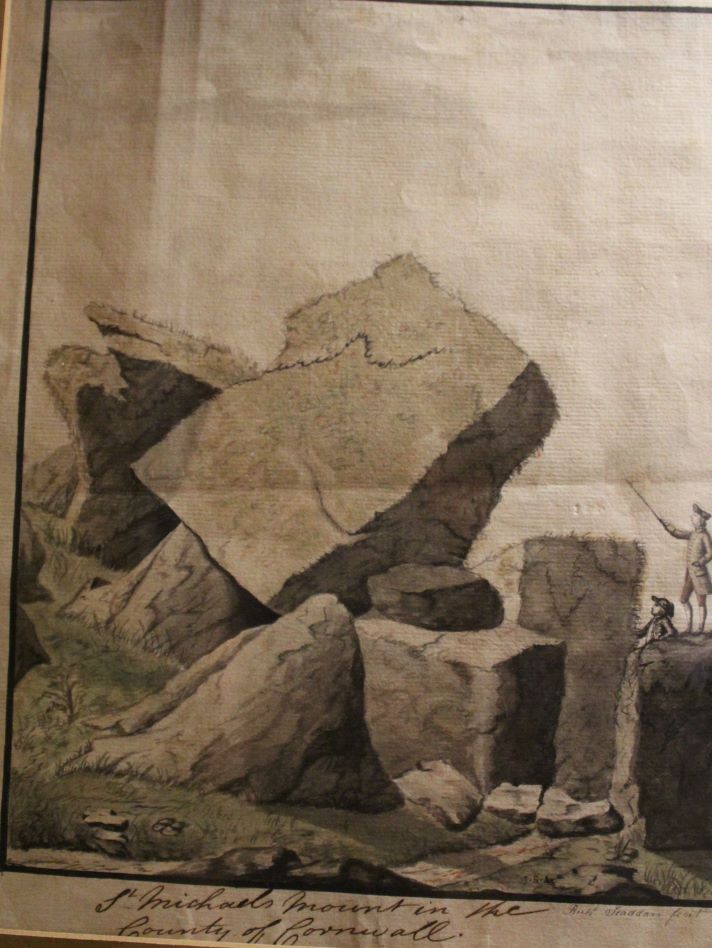
From ‘Relics of Antiquity’ (1811).

From ‘Relics of Antiquity’ (1811).

Midsummer afternoon, from Marazion beach.

From a stained glass window in the church on the Mount.




St Michael vanquishing a devil, thee devil? then offers him a helping hand.




Zoomed at from HMS Nausea en route to the Scilly Isles.

Hazy morning, almost Midsummer. From Penzance harbour.

July 2012

As part of TMA’s occasional series of wildlife sightings pics, I present St Michael’s Mount with dolphins (which swam right under our boat a few minutes later).

St. Michael’s Mount and the causeway.



“At the end of 2009, an exciting discovery was made on the Mount when parts of an axe-head, dagger and intact metal clasp were found. The British Museum has confirmed these dating back to the Bronze Age and this extraordinary find – evidence of life on the Mount for three millennia – will go on display in the castle this Spring.”
Visited 11.4.10.
Visible from miles and miles around. I parked near the sea front (does anywhere in Cornwall know the meaning of ‘free parking’?) and took a gentle stroll across the causeway to the island. Had a cuppa, bought an interesting little book on Cornish prehistoric sites and strolled back – very nice!
.. on the beach at the foot of the hill is the “Chapel Rock” whereon once stood an oratory of which Leland speaks of “a little chapel yn the sande nere by the towne toward the Mount,” and where (on what authority I know not) many of our local histories tell us pilgrims were wont to halt before making the ascent.
But the Chapel Rock has other interests than that derived from the building that once stood on it. Having already carried off the top of the neighbouring hill of Trencrom, to make the Mount itself, Cormoran was in want of further stones wherewith to build his castle, and sent his wife to fetch them from the same place. She, thinking (womanlike) that any other stone would do as well, fetched this one from the nearer hill of Ludgvan-lees. Angry at her conduct, the monster slew her with his mighty foot, and the great rock rolled from her apron and fell where we now see it; a silent witness to the lady’s strength and the truth of the narrative.
Maybe the hill of Ludgvan-lees is the one at Castle-an-Dinas. From Notes on St. Michael’s Mount by Thurstan C Peter, in the Journal of the Royal Institution of Cornwall v14 (1899-1900).
There is a well on this mount which was in former days named “Giant’s” Well, on account of the giant Cormelian, or Cormoran, who inhabited the spot. The well, or cistern, is excavated in the rock; it is still in existence, but is now known by the title of “Jack the Giant Killer’s Well,” and is fairly well lined with pins thrown there by persons desirous of procuring their wishes. The conclusion to be drawn is that the clever youth “Jack,” who by stratagem ridded the mount of its monster by killing the giant Cormoran, was honoured by the change of the well’s designation as a recognition of his service.
From ‘Ancient and Holy Wells of Cornwall’ by M and L Quiller-Couch (1894).
The tradition that the Mount was formerly called in old Cornish, Careg-luz en kuz*, and that it rose from the midst of an extensive forest, is very prevalent. “A forest is supposed to have extended along the coast to St Michael’s Mount, which was described as a ‘hoare rock in a wood,’ and stood five or six miles from the sea. The bay was said to have been a plain of five or six miles in extent, formed into parishes, each having its church, and laid out in meadows, corn-fields, and woods.”
*or Careg cowse in clowse--i.e., the hoary rock in the wood.
This and much other folklore connected with the island at the online version of Hunt’s ‘Popular Romances of the West of England’, at the sacred texts archive:
sacred-texts.com/neu/eng/prwe/prwe088.htm
Do giants always have to reach a sticky end?
The giant on the Mount and the giant on Trecrobben Hill were very friendly. They had only one cobbling-hammer between them, which they would throw from one to the other, as either required it. One day the giant on the Mount wanted the hammer in a great hurry, so he shouted, ” Holloa, up there! Trecrobben, throw us down the hammer, woost a’?”
“To be sure,” sings out Trecrobben; “here! look out, and catch ‘m.”
Now, nothing would do but the giant’s wife, who was very nearsighted, must run out of her cave to see Trecrobben throw the hammer. She had no hat on; and coming at once out into the light, she could not distinguish objects. Consequently, she did not see the hammer coming through the air, and received it between her eyes. The force with which it was flung was so great that the massive bone of the forehead of the giantess was crushed, and she fell dead at the giant’s feet. You may be sure there was a great to-do between the two giants. They sat wailing over the dead body, and with their sighs they produced a tempest. These were unavailing to restore the old lady, and all they had to do was to bury her. Some say they lifted the Chapel Rock and put her under it, others, that she is buried beneath the castle court, while some--no doubt the giants’ detractors--declare that they rolled the body down into the sea, and took no more heed of it.
From Hunt’s ‘Popular Romances of the West of England’ (1903 – 3rd ed) – online at the Sacred Texts Archive
sacred-texts.com/neu/eng/prwe/prwe014.htm
Pure Joy may be pleased to hear that there was a sequel to his story about the idle misogynistic giant. He met his death at the hands of Jack the Giant Killer – no doubt hired by the local people who were fed up. He snuck onto the mount one night and dug an enormous pit, covering it with sticks and straw to disguise it. Then, tooting loudly on a horn, he woke the giant. Cormoran, stumbling about (like you do when some idiot wakes you up in the middle of the night) fell straight into the hole, and Jack cracked him over the head with his axe – the giant died instantly. The local people were so grateful they gave Jack a magnificent sword and a belt embroidered with gold.
(story noted in the Reader’s Digest ‘Folklore Myths and Legends of Britain’).
By the way, it is said the you may still see the greenstone Mrs Giant dropped from her apron, on the causeway. And while you’re crossing, apparently you may see the remains of a fossilised forest around you – Michael’s Mount is known as ‘Carrick luz en cuz’ in Cornish: ‘The ancient rock in the wood’.
Legend has it that the hill was built by the giant Cormoran and his wife. They were using white rock which had to be carried some distance, so Cormoran’s wife tried to cheat by bringing local greenstone in her apron instead. Cormoran kicked her when he found out, her apron string broke, and she dropped the stone. Far be it for me to pour scorn on folklore, but it seems a pretty mixed up case of folklore, and all a bit male centric!
In 495 AD some fishermen had a vision of St.Michael over the summit of the mount. Thereafter it became a Christian settlement. St.Keyne came on a pilgrimage there and left her influence on a rough stone seat known as St.Keyne’s Chair. Whichever one a newly married couple first sits on the chair, he or she will dominate the marriage.
John Michell believes the Mount marks one end of a very long distance alignment which he called ‘the ‘St.Michael Line’, and which includes the Hurlers Stone Circles on Bodmin Moor and Brent Tor church on Dartmoor.
The handy little book Cornwall’s Archaeological Heritage (ISBN 090629452-5) gives a brief description of the Mount:
The Mount is likely to be Ictus, the Iron Age tin trading station recorded by Diodorus Siculus. Recent discoveries of a copper ingot and amphora sherds (5th-6th centuries AD) show it was important in the Post Roman period – a south coast Tintagel Castle.
Julian mentions this as part of his text on Mulfra Quoit, on page 165 of The Modern Antiquarian. He says that “for it is here that we have a clear view south to St. Michael’s Mount, known to the Ancient Greeks as Iktis. And it was to Iktis that the great Greek sea captain Pytheus came in 325 BCE, searching for the legendary tin islands that the Greeks called the Cassiterides.”



































































































































































































